Mission: Impact podcast & blog
Build a better world without becoming a martyr to your nonprofit cause
Listen on:
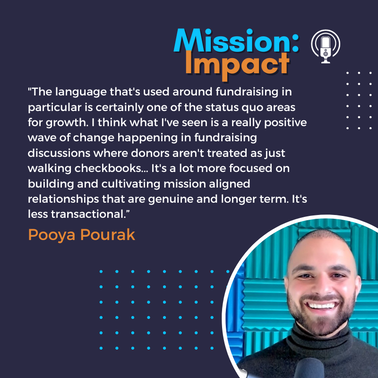 In episode 93 of Mission: Impact, Carol Hamilton and Pooya Pourak discuss the importance of transparent, impact-centric fundraising, the use of technology for efficiency, and the necessity of fair compensation for nonprofit employees. They delve into the nuances of donor engagement, exploring how to shift from a scarcity mindset to one of abundance and collaboration. They also discuss the potential of AI in the sector, while maintaining the human element that is essential to nonprofit work. Episode Highlights: 09:40 - Donor Engagement and Trust: Pooya presents statistics on donor engagement and trust, highlighting the disconnect between nonprofits and donors, and the strategies to improve transparency and communication. 12:00 Language and Fundraising: The conversation shifts to the language used in fundraising and how it affects donor relationships. They discuss the importance of genuine, mission-aligned connections over transactional interactions. 14:00 Shifting Status Quo Assumptions: Carol and Pooya discuss how nonprofits can break free from counterproductive practices and adopt strategies that promote long-term sustainability and diversified fundraising sources. 16:30 Nonprofit Ecosystem Complexity: Pooya reflects on the complexity of the nonprofit ecosystem, including the roles of various stakeholders, from other nonprofits to donors, foundations, and policy. 22:00 Testing Hypotheses in Fundraising: Pooya details the testing of two hypotheses aimed at increasing generosity and online giving, including the influence of unrestricted donations and the effectiveness of matching gifts. 31:00 The Future of the Nonprofit Sector: Looking ahead, Pooya anticipates the growing role of AI in the sector and emphasizes the need to balance technological advances with maintaining the sector's human-centered approach. 34:00 Fair Compensation The interview concludes with Pooya advocating for fair compensation in the nonprofit sector and encouraging a shift from competition to collaboration to enhance collective impact. Guest Bio:
Pooya Pourak Pooya is co-founder and CEO of MatchNice, a social impact tech startup on a mission to connect the nonprofit ecosystem and maximize social impact. His team is working on a new kind of impact-centric fundraising platform to increase transparency, engagement and accountability in digital fundraising. Pooya brings 15+ years of experience leading digital transformation across business, government, and now the nonprofit sector. He is the Host and Producer of The Nonprofit Lab, a podcast dedicated to the journey of discovery in the nonprofit sector with an aim to uncover and shake up the status quo. Pooya runs his own consulting practice where he helps our government listen to the needs of diverse stakeholders and put their feedback into action to inform large-scale systems delivery. Pooya holds a Bachelor of Science from Georgia Institute of Technology in Industrial & Systems Engineering and is also a certified yoga instructor. Important Links and Resources: https://www.matchnice.org/ https://www.linkedin.com/in/pooyapourak/ Charity Vest https://www.charityvest.org/ Google for Nonprofits https://www.google.com/nonprofits/ Click "Read More" to view a transcript of the interview. 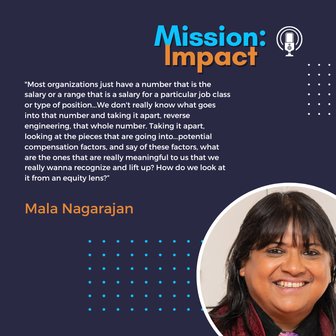 In episode 85 of Mission: Impact, Carol Hamilton and Mala Nagarajan discuss organizational development, compensation structures, and critical discussions within nonprofit organizations. They explore the limitations of market-based compensation, the concept of a thriving wage, and the importance of aligning organizational values with employee compensation. Mala emphasizes the need for transparent and comprehensive approaches to compensation, touching on various factors such as areas of responsibility, risk assessment, and the significance of understanding one's relationship with money. In addition they explore how to integrate compensating for the emotional labor required in a role. They discuss the complexities of legal considerations and highlight the need for organizations to reevaluate traditional practices to foster a more equitable and holistic work environment. Highlights:
02:27: Creating equitable compensation models for organizations 04:50: Principles underpinning the work 08:16: The importance of interdependence 13:08- Transparency in compensation 16:21 Emotional labor and compensation 26:00 - Recognizing individual strengths and aligning them with organizational roles beyond just financial incentives 32:00 - Biases and values embedded in market-based compensation structures 37:00 - Implementing a thriving wage, distinct from a living wage 45:00 - The "conditions for readiness" necessary for successful implementation 53:00 - Assessing risk tolerance Guest Bio: Mala Nagarajan is a senior HR consultant who works with nonprofit organizations rooted in racial and social justice values. She is driven by a vision of strong organizations working collaboratively toward a common purpose and approaches her HR work with a values-aligned, people-centered, and movement-oriented lens. Mala is a consultant with RoadMap, a national network of consultants who work with social justice organizations. She helped organize RoadMap’s HR/RJ (racial justice) working group. Mala has developed an innovative Compensation Equity Process and Calculator™ that reverse-engineers supremacy out and re-engineers equity in. It’s an evolving approach accompanied with a custom tool that organizations can use to shift from a market-based to an anti-racist compensation model that centers those living at the intersections of multiple marginalized communities. Important Links and Resources: Mala Nagarajan - https://www.linkedin.com/in/malanagarajan/ Vega Mala Consulting | www.vegamala.com Marilyn Waring TED talk on what the GDP misses -- https://www.tedxchristchurch.com/marilyn-waring Polarities: https://www.polaritypartnerships.com/ The MIT Living Wage Calculator: https://livingwage.mit.edu/ Hidden Brain episodes on budgets: https://hiddenbrain.org/podcast/money-2-0-why-we-bust-our-budgets/ Learn more about Mala’s compensation work here: Fund the People: Compensation Philosophy, NPQ-Compensation Equity: A Values-Based Framework & Implementation Guide, Top Tips to Stop Widening the Wealth Gap, Why Radical Human Resources is Critical for Movement Organizations, Equitable Compensation is a Risk Worth Taking, Brave Questions: Recalculating Pay Equity, Don't Put Metal in the Microwave and other Compensation Myths, Transforming the Workplace: HR Innovations, Pay Scale Equity Process and Calculator. HR resources: RoadMap Consulting: Human Resources and Justice: Addressing Racism and Sexism in the Workplace. Washington Nonprofits: Workers in Nonprofits. The Management Center: Making Compensation More Equitable. Click "Read More" for transcript 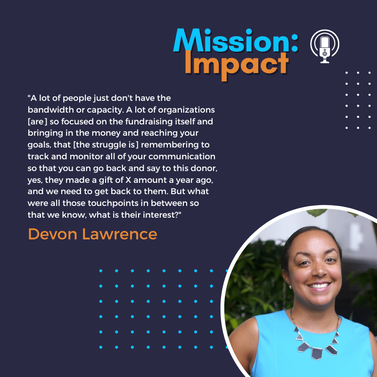 In episode 76 of Mission: Impact, Carol Hamilton and Devon Lawrence discuss
Guest Bio: Devon Lawrence is the Founder and Principal of Clark Lawrence Consulting, Inc. For 10+ years she has worked with non-profits of all sizes, both domestic and international, to advance their capabilities around development operations, fundraising events, project management and leadership. Her clients have praised her ability to be well attuned to the needs, opportunities, and challenges of non-profit organizations and her reliability as a source of guidance on fundraising and organizational development. Devon currently serves on the boards of the Bowery Residents' Committee (BRC) and Association of Nonprofit Specialists. She lives in New York City with her husband and two-year old son. Important Links and Resources:
Click "Read More" for Transcript: 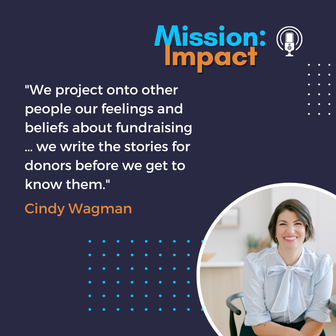 In episode 73 of Mission: Impact, Carol Hamilton and her guest, Cindy Wagman discuss:
Guest Bio: Cindy Wagman is the President & CEO of The Good Partnership. She helps small nonprofits raise more money and reluctant fundraisers learn to love fundraising. Important Links and Resources:
Click "Read More" for Transcript: 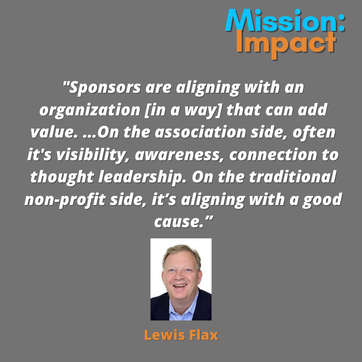 In episode 49 of Mission: Impact, Carol and her guest, Lewis Flax discuss:
Guest Bio: Lewis Flax specializes in assisting nonprofits and associations generate additional revenue. His hands-on approach has helped numerous organizations implement strategies and tactics to increase sponsorship, partnership, and other funding streams. His firm, Flax Associates, established in 2008, serves as a partner in driving revenue and results. Lewis understands the challenges nonprofits face, both from an outside consultant's point of view and from the internal perspective of a nonprofit executive. Previously, Lewis served as a Vice President for IEG (a sponsorship consulting firm) and served on the leadership team at Financial Executives International (FEI). He is a certified instructor for Dale Carnegie Training (Winning with Relationship Selling) and an AFP (Association of Fundraising Professionals) Master Trainer. Important Links and Resources: Click "Read More" for Transcript: |
Archives
April 2024

Grace Social Sector Consulting, LLC, owns the copyright in and to all content in and transcripts of the Mission: Impact podcast, as well as the Mission: Impact blog with all rights reserved, including right of publicity.
|
Telephone301-857-9335
|
info[at]gracesocialsector.com
|
Grace Social Sector Consulting, LLC, owns the copyright in and to all content in, including transcripts and audio of the Mission: Impact podcast and all content on this website, with all rights reserved, including right of publicity.
|